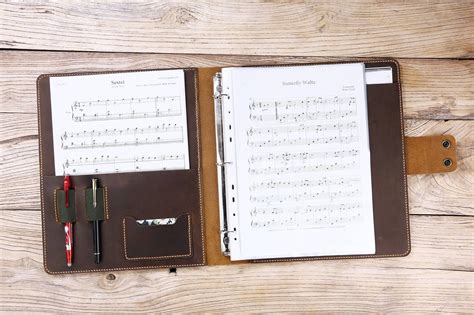Introduction

Sheet music is a crucial component of musical performance, composition, and education. To ensure its preservation and accessibility, organizing and storing sheet music effectively is paramount. Music binders serve as the perfect solution, offering a secure and portable way to manage extensive musical libraries. This article delves into the importance, types, benefits, and strategies for utilizing music binders for optimal sheet music organization.
Importance of Music Binders
- Protection: Binders provide a protective layer against damage caused by spills, wear, and tear, extending the lifespan of sheet music.
- Organization: They enable efficient categorization and retrieval of sheet music by genre, composer, or event, eliminating the hassle of searching through piles of loose papers.
- Accessibility: Binders allow for quick access to sheet music during rehearsals, performances, and practice sessions, ensuring musicians are well-prepared.
Types of Music Binders
- Ring Binders: These binders feature interlocking rings that hold punched sheets securely. They are versatile and allow for easy insertion, removal, and rearrangement of pages.
- D-Ring Binders: Similar to ring binders, D-ring binders have D-shaped rings that provide greater durability for handling larger volumes of sheet music.
- Screw Post Binders: These binders utilize screw posts to hold sheets in place. They are ideal for heavy-duty use and can accommodate thick or oversized sheets.
- Presentation Binders: Designed for professional presentations, these binders feature a rigid cover and often include features such as pockets or sleeves for additional materials.
Benefits of Using Music Binders
- Improved organization: Music binders provide a systematic way to arrange and categorize sheet music, making it easier to find the desired piece.
- Convenience: They offer a portable and organized storage solution, allowing musicians to transport their music library with ease.
- Space optimization: By consolidating sheet music into binders, it becomes more compact and space-efficient, freeing up storage for other items.
- Customization: Binders can be personalized with labels, stickers, or covers to reflect the user’s style and preference.
Strategies for Utilizing Music Binders
- Categorize and label: Organize sheet music into logical categories (e.g., classical, jazz, pop) and label binders accordingly for quick identification.
- Use color coding: Assign different colors to binder categories or types of sheet music to enhance visual organization and accessibility.
- Create an index: Maintain an index at the front of each binder with a list of pieces and their page numbers for easy reference.
- Utilize clear sheet protectors: Protect sheet music from dirt, moisture, and damage by using clear sheet protectors.
- Consider digital options: Utilize digital binder apps or software to supplement physical binders, providing additional backup and accessibility.
Tips for Choosing the Right Music Binder
- Size and capacity: Consider the size and number of sheets you need to accommodate.
- Type of binding: Select the binding type (ring, D-ring, screw post) based on your preferences for durability and ease of use.
- Cover material: Choose a cover material that is durable and resistant to wear and tear.
- Spine width: Ensure the binder has sufficient spine width to hold all the sheets you need to store.
- Portability: Consider the portability of the binder if you plan on transporting it frequently.
Table 1: Comparison of Music Binder Binding Types
| Binding Type | Durability | Ease of Use | Page Capacity |
|---|---|---|---|
| Ring Binders | Moderate | Easy | Medium |
| D-Ring Binders | High | Moderate | High |
| Screw Post Binders | Very high | Moderate | Extremely high |
Effective Strategies for Music Binder Organization
- Establish a systematic filing system: Develop a consistent naming convention and filing system to ensure logical organization and easy retrieval.
- Regularly purge and update: Remove outdated or unnecessary sheet music to maintain a concise and up-to-date library.
- Utilize dividers: Divide binders into sections using dividers to separate categories or subgroups of sheet music.
- Consider a tabbing system: Use tab dividers or color-coded tabs to quickly identify and access specific sections within binders.
- Maintain binder inventory: Regularly update an inventory of the contents of each binder for easy referencing and management.
Table 2: Benefits and Drawbacks of Music Binders
| Benefits | Drawbacks |
|---|---|
| Protection of sheet music | Can be bulky and heavy |
| Improved organization | Limited number of sheets per binder |
| Convenience and portability | May not accommodate oversized or heavy music |
| Customization | Can be expensive |
FAQs
- What size music binder should I use?
- The size depends on the number of sheets you need to accommodate. Standard sizes range from 1 inch to 3 inches.
- Which type of music binder is most durable?
- Screw post binders provide the highest durability for heavy-duty use.
- Can I use sheet protectors in music binders?
- Yes, clear sheet protectors are recommended to protect sheet music from damage.
- How do I organize a large sheet music collection?
- Use a combination of music binders, categorization, color coding, and digital options for efficient organization.
- Where can I purchase music binders?
- Music binders are available at music stores, online retailers, and office supply stores.
- How often should I purge my music binder collection?
- Regularly remove outdated or unnecessary sheet music to maintain a current and organized library.
Conclusion
Music binders are essential tools for organizing and protecting sheet music. By utilizing the strategies and recommendations outlined in this article, musicians can effectively manage their musical libraries, ensuring accessibility, preservation, and optimal performance. With the right music binders in place, musicians can focus on their craft and the joy of making music without the distractions of disorganized sheet music.
